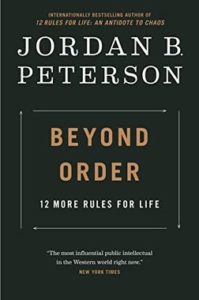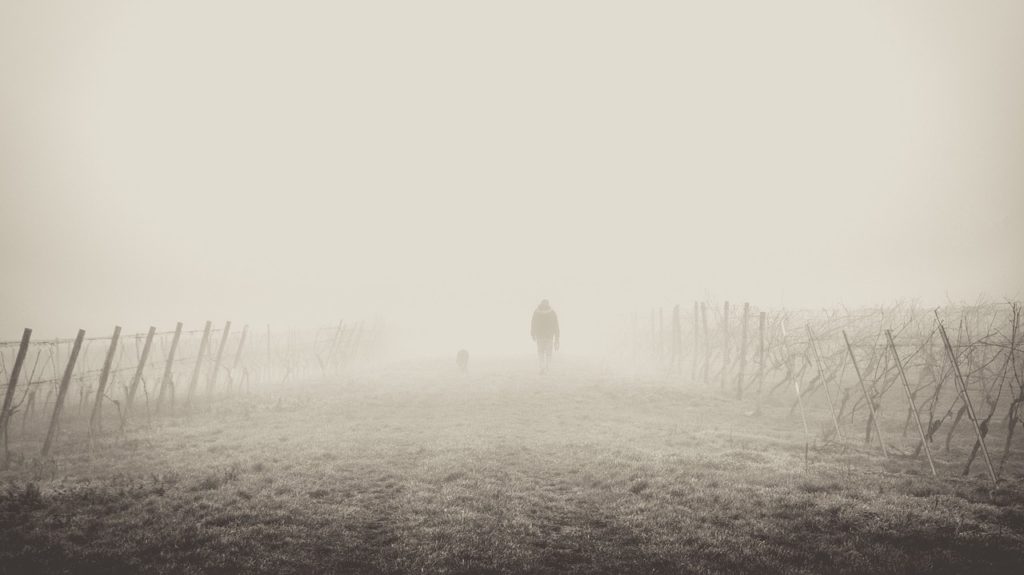Things fall apart of their own accord, but the sins of men speed their deterioration1
– Jordan B. Peterson
Psychologist Jordan B. Peterson’s Beyond Order: 12 More Rules For Life is the sequel to his bestseller, 12 Rules For Life: An Antidote to Chaos. As you might expect, Beyond Order follows a similar structure to 12 Rules, combining personal anecdotes, clinical cases, mythological interpretations, scientific research, and religious scripture, to ‘guide readers towards a more courageous, truthful and meaningful life.’
Unlike his previous work, ‘Beyond Order explores as its overarching theme how the dangers of too much security and control might be profitably avoided.’2 It is perhaps ironic, then, that Peterson’s attempt to control his emotional state, led to (or at least exacerbated) what likely ranks as the most chaotic period of his life.
Jordan Peterson’s Health Crisis: Overture to Beyond Order
 If you pile up enough junk in your closet, one day, when you are least prepared, the door will spring open, and all of what has been packed inside, growing inexorably in the darkness, will bury you, and you may not have enough time or energy left in your life to confront it, sort through it, keep what you need, and discard the rest.3
If you pile up enough junk in your closet, one day, when you are least prepared, the door will spring open, and all of what has been packed inside, growing inexorably in the darkness, will bury you, and you may not have enough time or energy left in your life to confront it, sort through it, keep what you need, and discard the rest.3
Jordan Peterson wrote Beyond Order ‘during a time when my family was plagued by sequential and overlapping bouts of seriously impaired health’. These events included his wife’s (Tammy) kidney cancer, his daughter’s (Mikhaila) ankle surgery, and his own medical complications following the use of psychiatric drugs.
Peterson’s health problems began in late 2016, ‘after suffering from what appeared to be an autoimmune reaction to something I had consumed during the Christmas holiday’. He described feeling ‘acutely and continually anxious, as well as freezing cold’ and was prescribed a benzodiazepine in early 2017.
(It is hard to ascertain the true origin of these symptoms but it is worth noting that Peterson had been taking ‘serotonin reuptake inhibitors such as Celexa for nearly two decades’; he said they had benefited him greatly but decided to stop using them in early 2016 ‘because a dramatic dietary change seemed to render them unnecessary.’)
Peterson would continue taking benzodiazepines, which he considered ‘a relatively harmless substance’, for ‘almost exactly three years’.
Things changed, however, in March 2019, at the onset of my wife’s medical battle. My anxiety spiked noticeably after Mikhaila’s aforementioned hospitalization, surgery, and recovery. In consequence, I asked my family physician to increase my dose of benzodiazepine, so that I would not be preoccupied by nor preoccupy others with my anxiety. Unfortunately, I experienced a marked increase in negative emotion following the adjustment. I asked to have the dosage raised yet again (by this time, we were attempting to deal with the second of Tammy’s surgeries and its complications, and I attributed my even more severe anxiety to that problem), but my anxiety increased even further. I attributed all of this not to a paradoxical reaction to the medication (which it was later diagnosed as), but to the recurrence of a tendency toward depression that had plagued me for years. In any case, I ceased using the benzodiazepine entirely in May of [2019], trying two doses of ketamine within a week, as suggested by a psychiatrist with whom I consulted. Ketamine, a nonstandard anesthetic/psychedelic, sometimes has overwhelming and sudden positive effects on depression. It produced nothing for me but two ninety-minute trips to hell. I felt to my bones as if I had everything to feel guilty and ashamed about, with nothing gained by my positive experiences.
To summarise, within three months, Peterson increased his benzodiazepine dosage twice; then went cold turkey; and then took two doses of ketamine – all of which occurred under the supervision of medical professionals.
We can perhaps forgive Peterson for going along with all this (although, one could equally argue he should have known better, since he is literally a clinical psychologist), given the mind-altering substances he had already been taking, and stress stemming from his family’s health situation and life as a controversial public figure. But his physician and psychiatrist?
The harmful effects of psychiatric drugs, including benzodiapines, have been well-documented. So much so, that the FDA recently announced that updated labeling for benzodiazepines would include ‘abuse, addiction and other serious risks’.
And what about abruptly ending one’s use of such substances?
A few days after the second ketamine experience, I began to suffer the effects of acute benzodiazepine withdrawal, which were truly intolerable—anxiety far beyond what I had ever experienced, an uncontrollable restlessness and need to move (formally known as akathisia), overwhelming thoughts of self-destruction, and the complete absence of any happiness whatsoever. A family friend—a physician—enlightened me as to the dangers of sudden benzodiazepine withdrawal. I therefore started to take a benzodiazepine once again—but a smaller dose than I had climbed to previously. Many, but not all, of my symptoms abated. To deal with those that remained, I also began to take an antidepressant that had been of great use to me in the past. All it did, however, was make me exhausted enough to require an additional four or more hours of sleep a day—which was not helpful in the midst of Tammy’s serious health issues—as well as increase my appetite two- or threefold.
It is alarming to think a family friend had to be the one to educate Peterson on the reality of benzodiazepine withdrawal, after his family physician and his psychiatrist, a supposed specialist, apparently failed to warn him of the dangers associated with the abrupt cessation of these drugs.
For about three months, Peterson experienced ‘terrible anxiety, uncontrollable hypersomnia, viciously torturous akathisia, and excessive appetite’. At which point, he traveled to an American clinic ‘that claimed to specialize in rapid benzodiazepine withdrawal.’ Peterson said he resided there from mid-August to late November. But by the time he returned home to Toronto, ‘the akathisia (the disorder of uncontrollable movement alluded to earlier) had increased to the point where I could not sit or rest in any position for any length of time whatsoever without severe distress.’
The following month, Peterson entered a local hospital. But in January of 2020, ‘believing that the treatment I received there was doing me more harm than good (an opinion I concurred with entirely once I learned of it)’, Peterson’s daughter and her husband moved him to an intensive care unit in Moscow. Peterson wrote that he does not remember much of this period.
The situation I found myself in upon reattaining consciousness in Russia was complicated by the fact that I had also developed double pneumonia in Canada, although that was neither discovered nor treated until I was in the Moscow ICU. However, I was there primarily so that the clinic could facilitate my withdrawal from benzodiazepines, using a procedure either unknown or regarded as too dangerous in North America. Since I had not been able to tolerate any decrease in dosage whatsoever—apart from the initial reduction, months before—the clinic placed me in a medically induced coma so that I might remain unconscious during the very worst withdrawal symptoms. That regimen started January 5 and lasted nine days, during which I was also placed in a machine so that my breathing was mechanically regulated. On January 14, I was taken off the anesthetic and the intubation. I woke up for a few hours, and indicated during this time to Mikhaila that I was no longer suffering from akathisia, although I remember nothing of this.
Following these events, Peterson was moved to another ICU ‘specializing in neurological rehabilitation’. He then moved to a ‘homelike rehabilitation center’.
While there, I had to relearn how to walk and [sic] up and down stairs, button my clothes, lie down in bed on my own, place my hands in the proper position on a computer keyboard, and type. I did not seem to be able to see properly—or, more accurately, see how to use my limbs to interact with what I perceived.
A few weeks later, Peterson relocated to Florida, where he ‘attempted to wean off the medication prescribed by the Moscow clinic’. His withdrawal symptoms persisted, however, and ‘about two months later I returned to the dosages initially prescribed in Russia.’ He relocated, once more, this time to a Serbian clinic ‘that practiced a novel approach to the problem of benzodiazepine withdrawal’.
Finally, in October 2020, Peterson published a video on his YouTube channel entitled ‘Return Home’, in which he announced:
I am back in Toronto and in much better health. Although, it’s still severely impaired – especially in the morning. But I can work again and I really want to.
Rule III: Do Not Hide Unwanted Things In The Fog

The fog that hides is the refusal to notice—to attend to—emotions and motivational states as they arise, and the refusal to communicate them both to yourself and to the people who are close to you. A bad mood signifies something. A state of anxiety or sadness signifies something, and not likely something that will please you to discover. The most probable outcome of successfully articulating an emotion that has accrued without expression over time is tears—an admission of vulnerability and pain (which are also feelings that people do not like to allow, particularly when they are feeling distrustful and angry). Who wants to dig down into the depths of pain and grief and guilt until the tears emerge?
Given the hellish withdrawal episode Peterson describes at the beginning of Beyond Order, the above excerpt is jarring, to say the least. Did Peterson ‘dig down into the depths of [his] pain and grief and guilt’? If he did, he chose not to mention it. We know he saw a family physician and psychiatrist, and repeatedly increased his benzodiazepine dosage to the point that he developed a chemical dependency. He also took ketamine. Twice.
Was he working with a therapist during this time? Was he journaling? Exercising? Praying? No idea. It’s not mentioned. This would be the perfect time to revisit his own experiences during that most stressful of times, and connect them with the rule he is encouraging his readers to adopt. But he doesn’t.
Peterson continues:
So, what might you do—what should you do—as an alternative to hiding things in the fog? Admit to your feelings. This is a very tricky matter (and it does not simply mean “give in” to them). First, noting, much less communicating, feelings of (petty) anger or pain due to lonesomeness, or anxiety about something that might be trivial, or jealousy that is likely unwarranted is embarrassing. The admission of such feelings is a revelation of ignorance, insufficiency, and vulnerability. Second, it is unsettling to allow for the possibility that your feelings, however overwhelming and convincing, might be misplaced and, in your ignorance, pointing you in the wrong direction. It is possible that you have misinterpreted the situation entirely, for reasons of which you remain fundamentally unconscious.
Did Peterson apply this advice during his own crucible? Based on his personal account, he seemingly did everything he could to keep his anxiety at bay (via chemical means), rather than confront it.
And it is very possible that you are wrong about just what is causing you to feel the way you do. If you are, you need to know it, because there is no point in propagating errors that are causing you and others pain and interfering with your future. Best to find out what is true—best to disperse the fog—and find out if the sharp objects you feared were lurking there are real or fantastical. And there is always the danger that some of them are real. But it is better to see them than to keep them occluded by the fog, because you can at least sometimes avoid the danger that you are willing to see.
Again, how does marinading in benzodiazepines and ketamine ‘disperse the fog’? This perhaps sounds callous. But I am genuinely at a loss. For Peterson to make such fervent and passionate protestations about how to face one’s demons, without reference to how he chose to combat his own, (1) makes him appear to lack self-awareness, and (2) seems like a huge missed opportunity to help the reader comprehend why he did what he did. He literally says to:
Confront the possibility that manifests in front of you every second of your life with the desire to make things better, regardless of the burden you bear, regardless of life’s often apparently arbitrary unfairness and cruelty. All other approaches merely deepen the pit, increase its heat, and doom those who inhabit it to continual worsening of their already serious problems. Everyone knows it. Everyone’s conscience proclaims it. Everyone’s true friend or loved one observes it and despairs when they see someone for whom they care failing to do what needs to be done. (emphasis added)
He also emphasises the importance of understanding one’s personal history, in order to avoid repeating past mistakes in the future:
The information in our experience is latent, like gold in ore….It must be extracted and refined with great effort, and often in collaboration with other people, before it can be employed to improve the present and the future. We use our past effectively when it helps us repeat desirable—and avoid repeating undesirable—experiences. We want to know what happened but, more importantly, we want to know why. Why is wisdom. Why enables us to avoid making the same mistake again and again, and if we are fortunate helps us repeat our successes.
Agreed. So, why did he choose to seek refuge in anti-anxiety pills? This question is not intended to imply that Peterson was ‘wrong’ to have taken them. Rather, it seeks to understand his thought process during that time, in light of what he is communicating to the reader in the present. The hope is that he would also share his thoughts on these drugs now. If he were to face similar stressors in the future, would he still opt for a psychiatric intervention? Would he suggest (as he has done in the past) that others take psychiatric drugs? None of this is explored.
Warning

Peterson does give one warning in Beyond Order to those thinking of visiting a psychiatrist. Readers of the book are forgiven for having missed it, since it is shared in the notes section, rather than the primary text (wherein Peterson is discussing a clinical case involving a man diagnosed with ‘schizophrenia’).
A word of advice for anyone seeking mental health help in a large city clinic, where the psychiatrist seeing you might take fifteen minutes to assess your life and determine the nature of your illness: do not casually mention any odd experiences or beliefs. You may well live to regret it. It takes very little to accrue a diagnosis of schizophrenia in the conditions that prevail in an overloaded mental health system—and once the diagnosis has been established, it is very hard to shake. It is difficult, personally, not to take a medical description seriously. It is harder than you might think to disbelieve a qualified psychiatrist (who should, after all, know what he or she is talking about), particularly if you are experiencing strange symptoms. It is difficult practically, as well, because once such a diagnosis becomes part of your permanent medical record, it is very difficult to have it modified. Anything out of the ordinary about you will, from then on, attract undue attention (even from yourself), and any displays of normality will be downplayed.
I would go even further (as have others). Like interactions with the police, whatever you tell a psychiatrist can be used against you. It is true that some people experiencing emotional distress find comfort in an answer, and a diagnosis provides one (albeit an inaccurate one). But for many, a psychiatric diagnosis is a medical brand that can never be removed. And as Peterson says, once labeled, you may become ensnared in a double-bind4 that you can never escape; the presence or absence of a behaviour can be interpreted as further evidence of the underlying disorder.
I have seen this happen. People who aren’t improving but nonetheless want to get off their psychiatric drugs, are told that they should continue taking them. Yet, when they report feeling better, they are still discouraged from tapering off their prescriptions. The diagnosed person’s subjective experience is, thus, divorced from the ‘treatment’.
Now, I say all that knowing full well that some people who have odd beliefs are in fact schizophrenic—but a fair bit of digging is usually in order to establish that diagnosis, and busy psychiatrists in public hospitals seldom have the time for careful excavation.
Despite his warning, Peterson remains convinced that there are genuine ‘schizophrenics’ out there. More rigorous testing is simply needed to identify them. This assumes the criteria undergirding psychiatric diagnoses are valid. They’re not.5 6 The criteria used to diagnose ‘schizophrenia’ (and all other psychiatric ‘disorders’) are fundamentally arbitrary. Psychiatric ‘disorders’ are invented, not discovered.7 They are not falsifiable. In the court of sanity, it is the anointed’s word versus yours.
‘You’re Not Going To Take Your Insulin?’
Not only was Peterson uninformed (or perhaps misinformed) about the risks associated with benzodiazepines, he also appears to have been misled about other psychiatric drugs. During a class that was uploaded to his YouTube channel in March 2017, he compares taking antidepressants for depression to taking insulin for diabetes. This fallacious analogy has been perpetuated ad nauseum, by laymen and experts alike (see Robert Sapolsky’s lecture on depression).
For those unaware, unlike diabetes, there are no laboratory tests for depression. Go to a psychiatrist and ask to have your serotonin levels measured and he will stare blankly at you. This means that if you do decide to take SSRIs, there is no way to objectively measure a change in your neurotransmitter levels, the way doctors can track insulin levels for diabetes. You are simply rolling a dice and hoping they have a positive impact – which they do…some of the time. But not necessarily because they fix an ostensible ‘imbalance’ in your brain. Rather, because of the placebo effect.8 The expectation that your mood will improve upon taking a pill has a powerful effect on how you come to feel in the future.
More Rules, More Problems?
Last year, I published a piece about Peterson’s previous book, 12 Rules For Life. The article critiqued the parenting advice in Rule 5: ‘Do not let your children do anything that makes you dislike them’. It argued that Peterson’s support of corporal punishment was not only empirically unsupported (quite the opposite – the data suggest it is harmful to children’s development), but downright hypocritical, given the rules he recommends children imbibe (e.g. ‘don’t hit’).
So, does Beyond Order also fall short? First of all, Peterson doesn’t revise any of his original parenting advice. Thus, we can assume that he still supports the physical punishment of children. Second, like 12 Rules, Peterson makes factual claims without providing supporting evidence (e.g. that certain people with ‘odd beliefs’ are ‘schizophrenic’). Third, there are some interesting passages in Beyond Order. The trouble is, in order to find them, the reader must wade through a fairly incoherent and disjointed mishmash of prose.
In sum, those who enjoyed Peterson’s previous work will likely enjoy Beyond Order. But the book probably won’t recruit any new acolytes to Peterson’s chaos/order worldview.
Beyond Order was an opportunity for Jordan Peterson to connect his own psychological and spiritual journey with a selection of his publicly professed rules for life. Unfortunately, the book fails to integrate the two. Thus, the reader is left unsure how (or if) the author actually applies his own rules. This doesn’t mean one cannot learn from them. It’s just unfortunate that the book’s message is hampered by its messenger.
In any case, I am thankful Beyond Order exists; if only because it serves as a cautionary tale for anyone looking to modify their mood using psychiatry’s plethora of pills. Whether Peterson is aware of (and willing to acknowledge) it or not, such drugs have myriad harmful effects (e.g. sexual dysfunction,9 10 brain abnormalities,11 suicide,12 violence,13 mortality,14 and neonatal complications15) and do not correct the purported brain imbalances for which they are frequently prescribed.
Use of the term drugs is deliberate, here. Viewing these substances as curative medications is a mistake, as several experts have shown. Therefore, proceed with extreme caution – and don’t expect your doctor (or psychiatrist) to have an in-depth knowledge of the risks these drugs pose.
A version of this article was published by Mad in America.
Footnotes
- Peterson, J. B. (2021). Beyond order: 12 more rules for life. New York: Penguin.
- Peterson, 2021
- This, and subsequent quotes (if not otherwise specified), are derived from Beyond Order (Peterson, 2021).
- Bateson, G., Jackson, D. D., Haley, J., & Weakland, J. (1956). Toward a theory of schizophrenia. Behavioral science, 1(4), 251-264.
- Ghaemi, S. N. (2016). Utility without validity is useless. World Psychiatry, 15(1), 35.
- Kirk, S. A. (2017). Mad science: Psychiatric coercion, diagnosis, and drugs. Routledge.
- Davies, J. (2017). How voting and consensus created the diagnostic and statistical manual of mental disorders (DSM-III). Anthropology & Medicine, 24(1), 32-46.
- Kirsch, I. (2014). Antidepressants and the placebo effect. Zeitschrift für Psychologie, 222(3), 128–134.
- Montejo, A. L., Llorca, G., Izquierdo, J. A., & Rico-Villademoros, F. (2001). Incidence of sexual dysfunction associated with antidepressant agents: A prospective multicenter study of 1022 outpatients. The Journal of clinical psychiatry.
- Simonsen, A. L., Danborg, P. B., & Gøtzsche, P. C. (2016). Persistent sexual dysfunction after early exposure to SSRIs: systematic review of animal studies. International Journal of Risk & Safety in Medicine, 28(1), 1-12.
- Breggin, P. R. (2012). Psychiatric drug withdrawal: A guide for prescribers, therapists, patients and their families. Springer Publishing Company.
- Sharma, T., Guski, L. S., Freund, N., & Gøtzsche, P. C. (2016). Suicidality and aggression during antidepressant treatment: systematic review and meta-analyses based on clinical study reports. bmj, 352.
- Moore, T. J., Glenmullen, J., & Furberg, C. D. (2010). Prescription drugs associated with reports of violence towards others. PloS one, 5(12), e15337.
- Coupland, C., Dhiman, P., Morriss, R., Arthur, A., Barton, G., & Hippisley-Cox, J. (2011). Antidepressant use and risk of adverse outcomes in older people: population based cohort study. Bmj, 343.
- Eke, A. C., Saccone, G., & Berghella, V. (2016). Selective serotonin reuptake inhibitor (SSRI) use during pregnancy and risk of preterm birth: a systematic review and meta‐analysis. BJOG: An International Journal of Obstetrics & Gynaecology, 123(12), 1900-1907.



